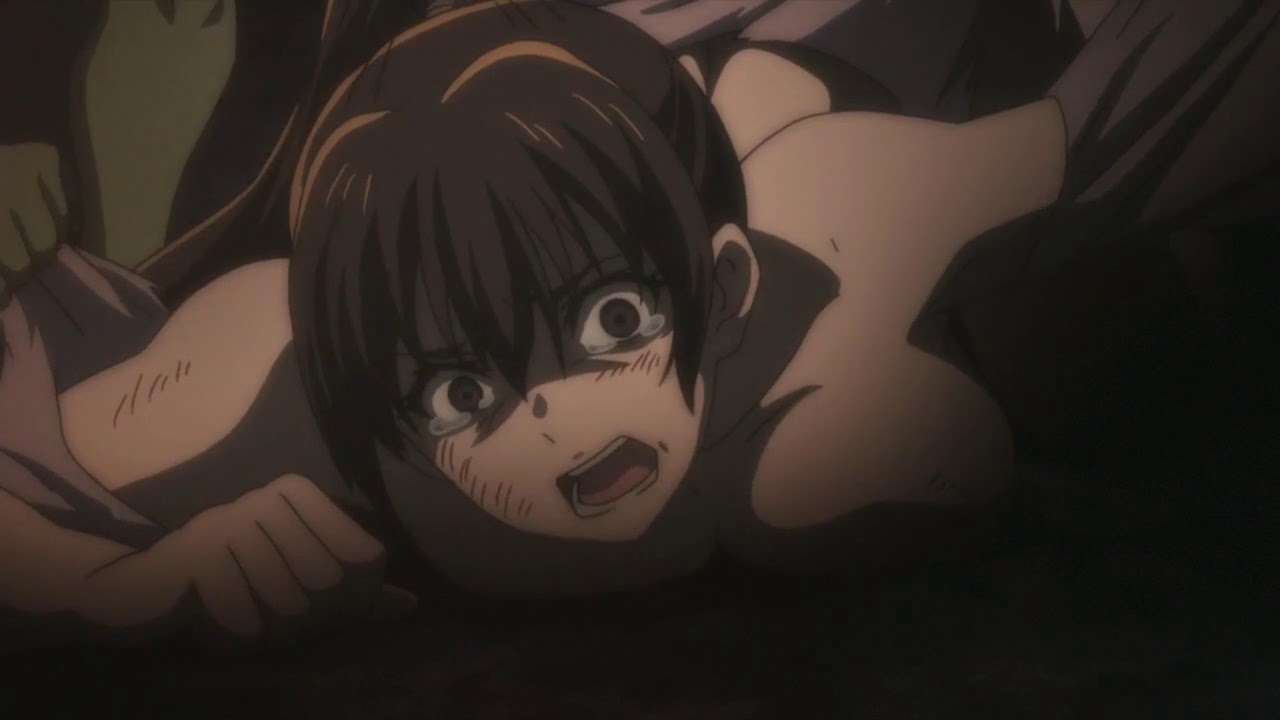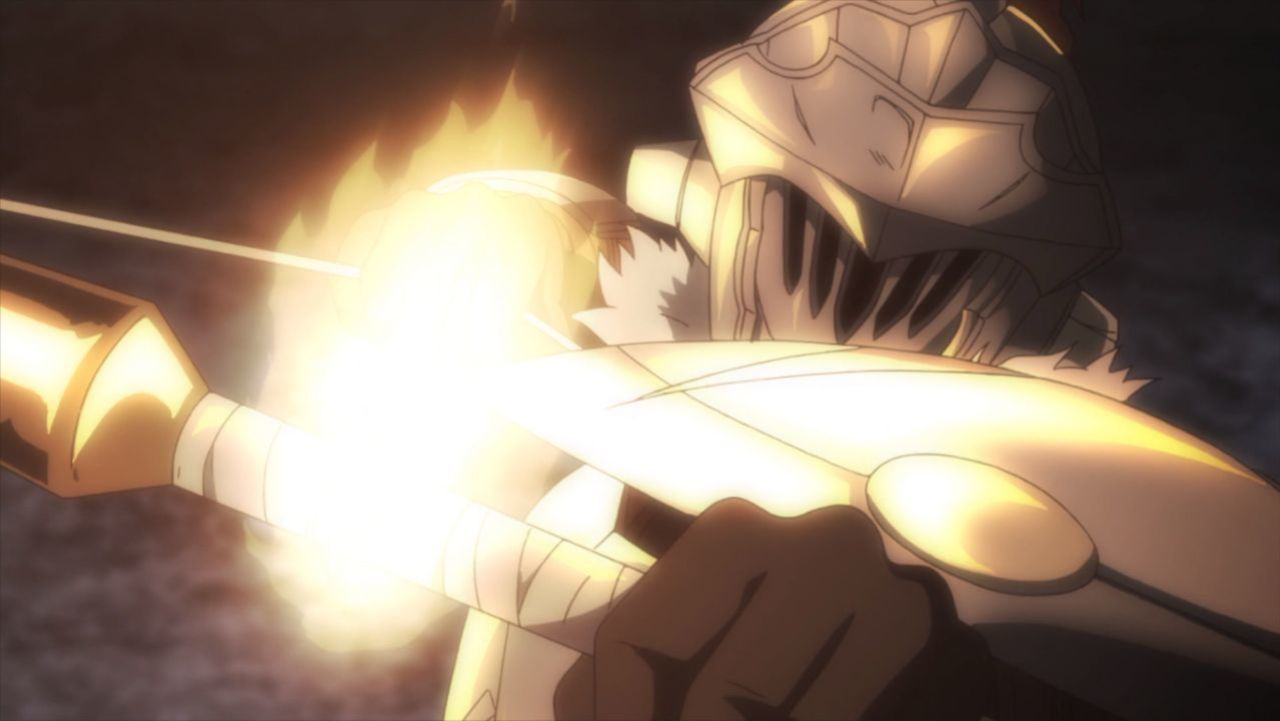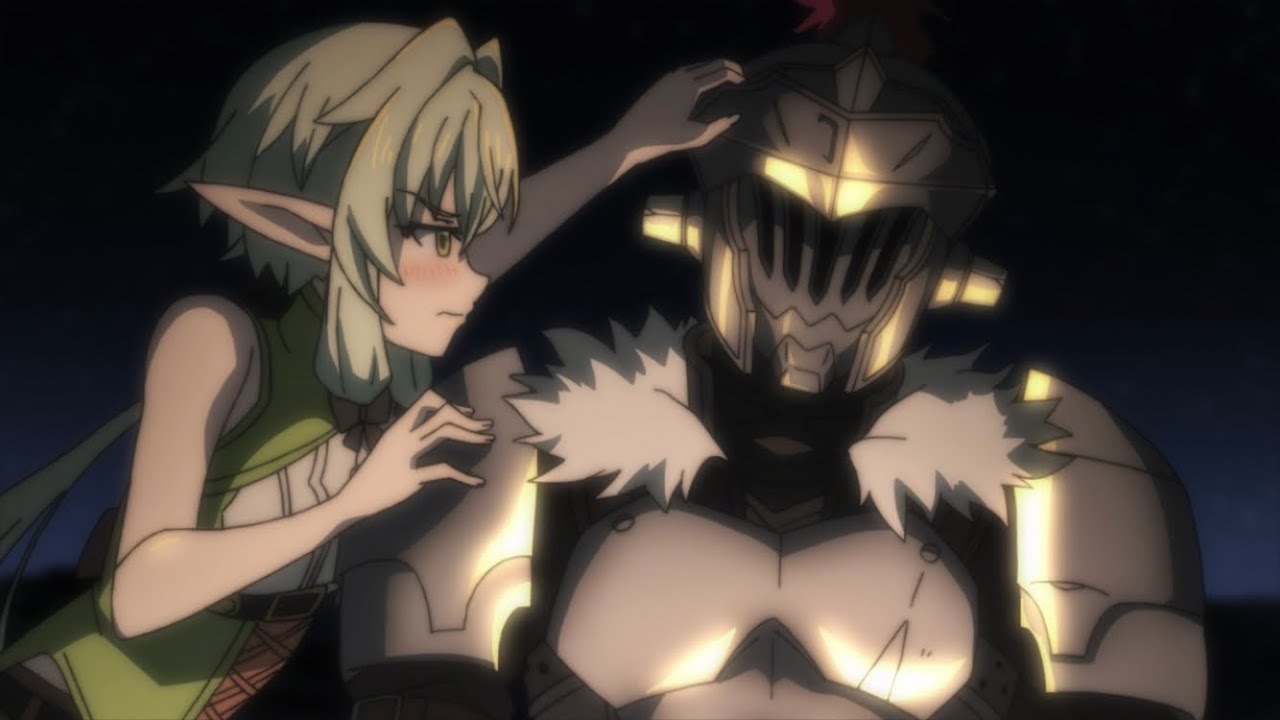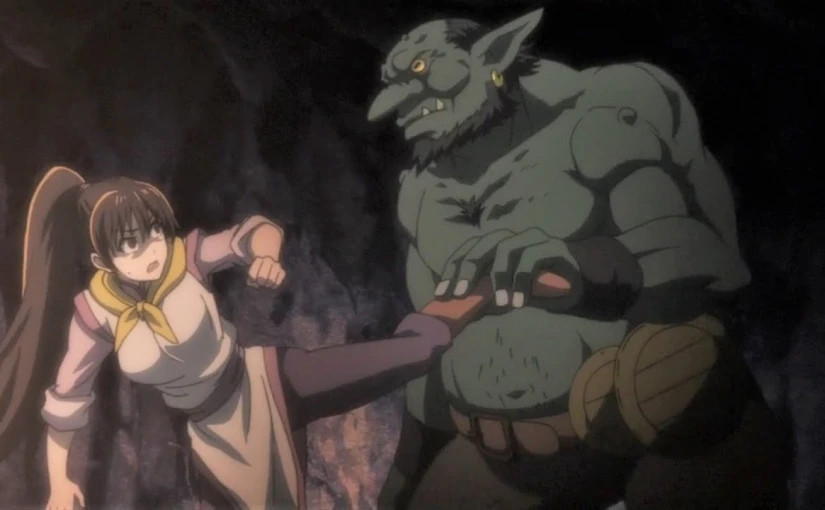(note: this article is from an anime-only perspective, and is primarily aimed at anime-only viewers)
Medieval fantasies often have trouble with the agency they give to women in their worlds, from societies over-populated with passive princesses to ‘strong female characters’ that have little complexity beyond being, well, strong and female. These stories are always under the shadow of period of history that saw the height of a patriarchal social structure and the treatment of the ‘fairer sex’ as little more than property. Modern writers should feel encouraged to subvert tropes and cliches in order to find new room for characters other than knightly men to flourish. Yet, one show this season has stumbled when it comes to handling a large part of its cast.
Goblin Slayer, a light novel adaptation under the direction of Girls Last Tour’s Takaharu Ozaki and scriptwriters Yousuke Kuroda and Hideyuki Kurata, caused an uproar from its very first episode after an opening segment of typical fantasy fare (wrapped in the cowl of an erroneous PG-13 rating) led anime-only viewers unaware into a rape scene. The latest episode of Sword Art Online has sparked similar controversy, but in SAO’s case complaints have been leveled both at the inclusion of the scene and at the attempts at censorship that left the sexual assault feeling even more dramatic and extreme. Goblin Slayer’s scene was less detailed, but it turned many people off the show just as it had begun, as fears abounded that sexualized violence would be the show’s only way of marking itself as ‘hardcore’.

Unfortunately, that seems to be all too much the case. In the ten episodes that have aired so far, Goblin Slayer has drawn practically every conflict towards the subject of the violation of women. In addition to the goblins putting young girls in peril in order to reproduce, and capturing and torturing many of their victims, the Demon Lord’s sect in episode 6 also had to have a naked girl bound up in order to look evil enough. The ogre in episode 5 threatens to violate our heroine if she survives; the hobgoblin in episode 7 makes her piss herself before biting off part of her arm; the Slayer’s backstory is directly rooted in the goblins using his sister ‘as their plaything’, so every bit of his motivation in battle could be said to have the memory of rape behind it.
While our hero focuses entirely on slaying goblins, something similar could be said for how all our villains concentrate their nastiness towards women rather than men.Sexual violence is a central part of Goblin Slayer’s plot and thematic map. As a child, the Slayer was told by his master that ‘it all begins with whether or not you’re going to do something, so do something’: he has to be an active hero, in order to save what are figured as passive victims. He is the stereotypical chivalric knight who has to rescue the damsels in distress. As much as there are female warriors in the story, their agency is diminished by the sexualized power of the goblins, as the Sword Maiden exemplifies with her fear of them. She defeated the Demon Lord, she is terrified of goblins because they took her virginity, and so her incredible power is undercut. ‘Women are weak creatures’, she says to the Slayer, an ultra-masculine knight who embodies the antithesis of fear with his unfeeling, armour-clad, calculated slaughter of her greatest enemy.

Though the party that defeats the Demon Lord is shown to be entirely female, their great battle is subverted into an aside for the ‘real’, down-to-earth struggle against goblins that the Slayer has devoted himself to; the Demon Lord might threaten the world, but goblins wage war against the sanctity of life itself. As we see in episode 8, the ‘miracle of resurrection’ requires the virginity of a woman. The preservation of bodily health is grounded in a traditional value of feminine purity, and the goblins exist as a force to corrupt that value. There are no female goblins, so their reproduction necessitates the violation of human women. The myth that envy turns you into a goblin also co-operates with their identity as little green rapists. Their existence is a corruption of a domestic order that the Goblin Slayer – haunted by his past failure of protecting his own domestic order – must protect at all costs; an order ultimately grounded in the value of sexual consent. But when every monster victimizes women in order to emphasize its evilness, the goblins lose their status as the prime corrupting force of natural life, and it makes less thematic sense for the Slayer to exclusively focus on them.

Having a particular monster species terrorize women in order to survive is one thing, but Goblin Slayer constructs very few other varieties of evildoing in its worldbuilding. The demoted scout in episode 5 still has to be shown to have the desire to murder an innocent lady, and the Slayer has to once again be a manly hero who prevents the suffering of women in the world; he’s even compared by Uketsuke-jou to other perverse men she’s met, reinforcing an idea that chivalric values are ultimately rooted in how one treats the ‘fairer sex’. We see this repeated in episode 8, as the shopkeeper leers at our heroine before being interrupted and intimidated by the Slayer, noticing his silver rank.
While embracing the DnD paradigm of ‘lawful’ vs ‘chaotic’, ‘good’ vs ‘evil’, the ‘good’ for men is rooted in their treatment of women much more than their homosocial ties with other men. We even see this in the side characters at the guild – most of the groups are paired boy and girl, man and woman. There’s little to talk about in terms of developed relationships between male characters, and we’re ten episodes into the show. It’s also disappointing that domestic bonds are figured as being fixed in the heteronormative, men acting unto women in order to prove their worth. It’s rare that women save other women, or men other men.

The paradigm is set in stone – the Slayer is the masculine strength that must protect the world, but the women around him must teach him to be more human, more feeling towards others. It’s a hegemonic approach – men must be strong but unfeeling, and women weak but caring. The Slayer could be read as a site of identification for men who feel skilled at their jobs while being unable to connect to the world they’re serving with those skills, but such a parallel doesn’t have to be established with women positioned as an inferior ‘Other’. Our heroine is always looking to the Slayer for the next move, and the female elf of the party isn’t even named, which emphasizes how little impact she has on the larger plot at all. While the dwarf and lizardman are also without names, they are always steadfast in battle: it’s the elf that’s regularly shown to be dealing with fear.
What disappoints me the most is that medieval narratives of chivalric ‘Romance’ weren’t restricted to this treatment of women back in the days when they were first formed: they did not even necessitate the forging of ‘romantic’ bonds between man and woman in the modern sense of the word. In Gawain and the Green Knight, what defines Gawain is mainly his engagements with other male knights, and this does not rely on a simple binary of ‘good’ knights treating women with respect and ‘bad’ knights being rude or harmful towards them. Even at a time when women were considered much more as property than today, chivalry was as much about your oaths to other men; your loyalty, your prowess at defending your honour and that of others. Like many other stories of its kind, Goblin Slayer falls into the trap of donning the medieval attire but losing sight of the complexities that made the original knights in shining armour so compelling.

Violence against female characters should remain an important part of what can code masculine villains as villainous, but we need to have more dimensions for evildoing in medieval fantasy worlds. The threatening of women is commonplace for any warring tribe, but their victimization in Goblin Slayer has overstayed its welcome, and this problem is exacerbated by the Slayer’s identity being founded upon how women perceive him as something greater than other men – and themselves – because of his unfeeling slaughter of little green rapists. When chivalry is limited like this, it limits the role and agency of female characters, and becomes rotten at its core.
A lot of tropes and cliches in anime are a blast, but the stereotypes that make up Goblin Slayer’s storytelling structure are crumbling columns that have borne the loads of hundreds of years of hackneyed representations of female characters. The story needs more weight to keep itself upright – modern medieval fantasies can’t be built on the idea that women need men to be their strength.



When you think about chivalric romances and Goblin Slayer, you might say that Goblin Slayer has more in common with Homer’s Iliad and other ancient Greek epics. In the Greek epics, women were mostly valuable possessions who needed protection from the outside world by their men; otherwise, other men would snatch the women away and make them their wives, concubines, or slaves. Not many women stood out from that paradigm except for goddesses (you might compare the Hero in Goblin Slayer to Athena or Hera) and atrociously wicked women like Clytemnestra and Medea. When it comes to good women in the heroic mold in the ancient Greek plays, only Antigone and Penelope come to mind, and these had heroic virtue but no feats of arms.
When it comes to the threat of sexual violence in chivalric romances, only a couple come to mind. Sir Walter Scott’s Ivanhoe includes such a scene, but Sir Brian de Bois-Guilbert quickly switches from lust to worship when Rebecca threatens to jump out of a window rather than submit. But, Ivanhoe is a modern work. If you turn to the High Middle Ages, the rambling pages of Le Morte D’Arthur might have one (Sir Thomas Mallory himself was charged with rape at one point), and Orlando Furioso by Ludovico Ariosto includes an attempted rape by a sorcerer. But, sexual assault is something even rather bad knights thought beneath them in these romances. As for Sir Gawain, his respect for the fair sex forbids him even to rebuke Bertilak’s wife for trying to draw him into adultery!
The Goblin Slayer himself seems to be in a middle position between Achilles and Sir Gawain: he sees neither women nor booty as his just due and lacks the courtly grace to romance the women around him–even his friend from childhood who so obviously desires him. He has the strength of Achilles and the restraint of Sir Gawain. In either culture, Goblin Slayer would be seen as an oddball. Since he shows no desire to dominate his fellow adventurers, show off, or to bed even the women who desire him, I cannot really see him as ultra-masculine–scarred and masculine might be more accurate.
More than any of the other characters, the women make the hard, unforgiving world of Goblin Slayer relatable to the audience. The High Elf has the emotional responses we might expect to Goblin Slayer’s stolid character and the horrors of the world. Priestess has that scared yet courageous persona moderns identify with better than devil-may-care bravery. Even the Sword Maiden reflects the feelings of isolation and loneliness so rampant in modern society. They are more human than the men in that way.
LikeLiked by 2 people
Wow, you’ve basically put together a whole extra article with this comment! I agree that overall the Slayer avoids many masculine traits – I mostly considered him ‘ultra-masculine’ because his dynamic of stoic, unfeeling strength dominated his character at every turn.
The women definitely humanize the world for the audience, but the fact they embody the majority of that ‘relatable’ response further reinforces for me a paradigm of women being about emotions, and men being about their brawn.
Thanks for the really in-depth reply – I should return to my notes from studying mediaeval fiction in uni and see if I can dig up any other examples of sexual violence in chivalric literature.
LikeLiked by 1 person
Not a single mention of the Chosen Hero and her party who are fighting the Demon Lord and his minions.
LikeLike
…no, I do mention that. I discuss how it’s treated as an ‘aside’ to the main story and how it’s value is subverted.
LikeLike
It’s a significant part of the world building of this story. It shows that while the story follows Goblin Slayer and his party, he’s not the true “hero” or main character of this world. The author has talked about this.
Also, we typically see the female adventurers fighting alongside the men and treated as their equals. They have equivalent status to the men as adventurers in terms of their ranks. Their gender does not stand in the way of their promotion or raising their status because they are a woman.
LikeLike
come to think of it, why couldn’t Goblin Slayer just hire the OP heroes that slayed the demon lord? he’s sure to have saved up some money by constantly taking goblin quests and using the goblins’ weapons against them.
though goblin quests being low reward makes no sense, considering goblin raids are common thus demand would be up. also, veteran adventurers would undoubtedly know how dangerous goblins are, considering that they likely had to experience it when they started out, even accounting for survivorship bias (the fact that it takes 3 newbie parties to clean out a goblin nest). not to mention that big business would come down hard on the goblins, since they’re killing their customers. that’s why big business is perfectly fine with civil rights, as it gives them access to a new market, but fights hard against regulations and unions.
oh well, the flaws of building your story on a DnD campaign
LikeLike
He had money but he didn’t have THAT much money. The goblin quests don’t give that much it’s just that there are a lot of them and he does all of them, even the ones that don’t give almost any money. Also I am pretty sure the OP heroes would have declined the offer regardless of the money, as not only are they really well known heroes who are supposed to fight the demon lord and other big monsters. Everyone makes fun of goblin slayer for only picking goblin quests, and the other heroes brag about fighting big monsters. In that kind of world I don’t think the heroes would accept a quest to fight goblins. Also it’s actually more useful for them to not be fighting goblins since they’re strong enough to tackle strong threats against the world.
LikeLike
Fancy that though, a story about how utterly evil and despicable the goblins of its setting are because of the utterly evil and despicable things they do…
…and the story is panned for it.
The erroneous pg-13 rating is to blame, as are all the people stupid enough to think the story in any way whatsoever condones the poor treatment of women it contains.
That the story’s actual flaws are ignored in favour of perceived flaws that it does not have is appalling.
LikeLike